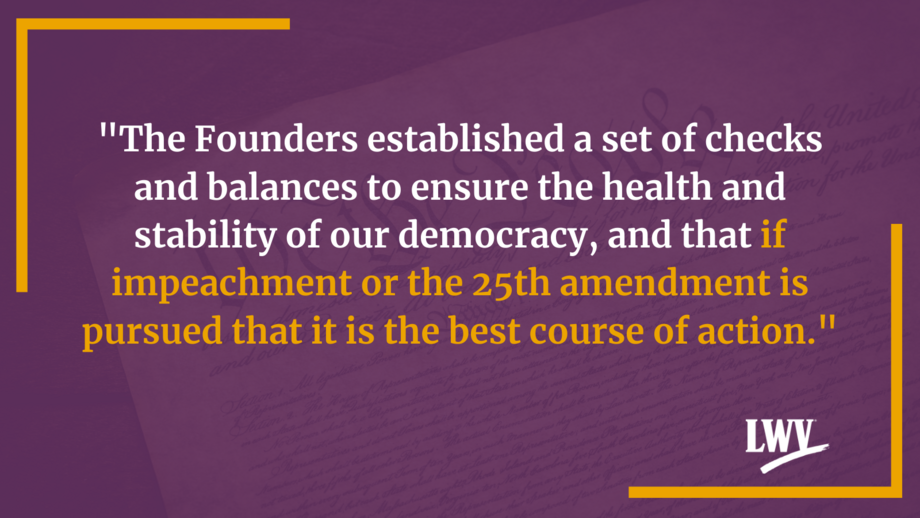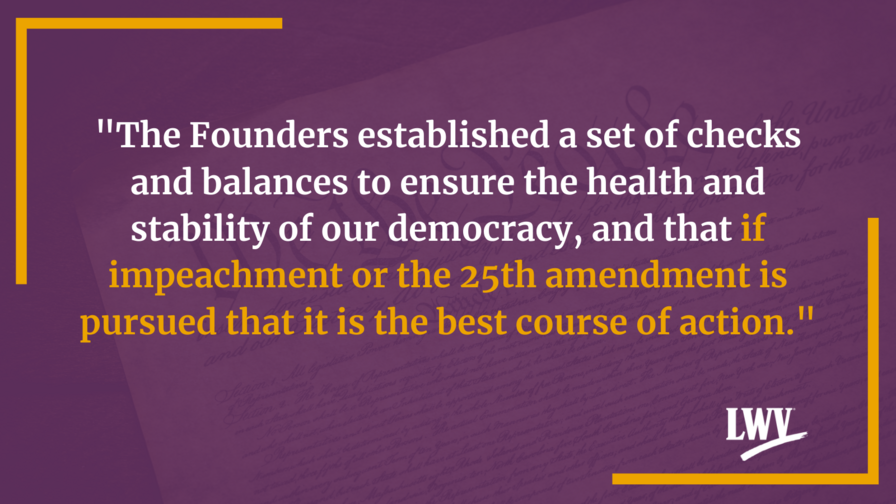In the Know: How Impeachment & the 25th Amendment Work
People are raising questions about the 25th amendment and impeachment. These processes are part of our checks and balances and were created to be difficult to overcome.
What is the 25th Amendment, and how does it work?
In 1965, the 25th amendment was passed to clarify the line of succession for when a President resigns, dies, or otherwise becomes incapacitated. It ensures that there is always a clear person in charge of the government in the case of an emergency. The amendment provides an option for temporary or permanent removal depending on who invokes the amendment and the circumstances. The fourth and last section of the amendment provides a process for the Vice President and a majority of the Cabinet to remove a president who is “unable to discharge the powers and duties of his office.”
Stay Updated
Keep up with the League. Receive emails to your inbox!
The first section of the 25th Amendment provides an avenue for the temporary removal of the President. This situation usually comes into play when a President knows that they will be undergoing surgery and will be temporarily incapacitated. In this situation, the President and a majority of the Cabinet will send a letter to the President pro tempore of the Senate and the Speaker of the House stating that the President will temporarily be unable to perform his or her duties. Once the President is no longer incapacitated, they will send a second letter to Congress stating that they are capable of performing their duties again.
The last section of the amendment provides the Vice President and the Cabinet with an option for permanently removing a president from office. The first step involves the Vice President and a majority of the members of the cabinet sending a letter to the president pro tempore of the Senate and the speaker of the House stating that the President cannot complete his or her duties. Since the Vice President and the Cabinet began the process, the President is temporarily stripped of his powers of office, and the Vice President would become the acting President once Congress receives the letter.

The President can still send a letter to Congress saying that they can perform their duties, which would reinstate their powers of office unless the vice president and the cabinet send another letter reasserting their initial claims. Once the first letter is received, Congress is required to convene within 48 hours and to vote within 21 days. If two-thirds of both houses of Congress vote to agree with the assertions in the letter, the President will permanently be stripped of his or her powers of office.
Hollywood has depicted the 25th Amendment shows like the West Wing and Designated Survivor, but in reality, the amendment has only been used a handful of times. Examples include the vice president vacancy under President Nixon and when Presidents Ronald Reagan and George W. Bush underwent medical procedures. The last section of the amendment, which provides an avenue for permanent removal, has never been used.
How does impeachment work?
The Constitution allows Congress to remove a President from office if enough lawmakers in both houses vote that the President is guilty of “treason, bribery, or other high crimes and misdemeanors.” Our founding fathers did not provide a detailed list of examples of what constitutes high crimes and misdemeanors; historically, it has been interpreted to mean an abuse of power by a high-level public official.
Alexander Hamilton described an impeachable offense as “those offenses which proceed from the misconduct of public men, or, in other words, from the abuse or violation of some public trust.” Some past examples have included removing a cabinet member in violation of federal law, lying under oath, and obstruction of Congress. Impeachment is a political process, not a legal one so that proceedings can occur even after a President’s term of office ends.
The impeachment process usually begins when the House of Representatives initiates a formal impeachment inquiry. The House Judiciary Committee will then investigate the charges, and if it finds enough evidence to support the claims, its members will write articles of impeachment that will be sent to the full House for a vote. In extreme cases, articles of impeachment can be written and sent to the full House for a vote. Only a simple majority is needed to pass the articles of impeachment.

Once a president is impeached, the articles are sent to the Senate for a trial. The Chief Justice of the Supreme Court will act as the judge or Presiding Officer, and the senators effectively act as jurors. The Senate’s impeachment rules detail the specific steps for organizing the trial, including appointing House managers to present the case against the impeached president in the Senate. At the end of the trial, if two-thirds of the Senate, sixty-seven senators, convict, the President will be removed from office. Without the supermajority vote, the President will remain in office.
If a President is convicted, the Senate can impose additional consequences such as disqualifying the person from holding “an office of honor, trust, or profit.” This means the President could not run for federal office again. Any additional consequences would have to be approved by a simple majority.
Neither path for removing a President was meant to be easy. Hopefully, it is clear why the Founders established a set of checks and balances to ensure the health and stability of our democracy and the importance of this constitutional application.
The Latest from the League
Donald Trump must be immediately removed as President of the United States of America and banned from running for federal office ever again.
Impeachment does not mean removal of an elected official from office. As a nonpartisan organization, the League of Women Voters offers this unbiased information to voters seeking to learn more about the impeachment process.
The Senate must serve as impartial jurors not tied to party lines, and convict him, ensuring that Donald Trump is banned from running for federal office again.
Sign Up For Email
Keep up with the League. Receive emails to your inbox!
Donate to support our work
to empower voters and defend democracy.





